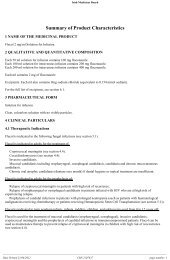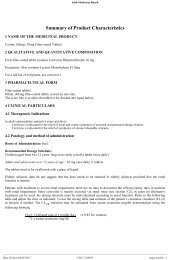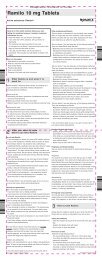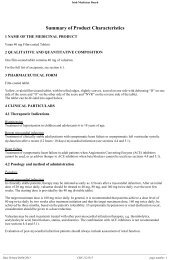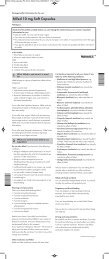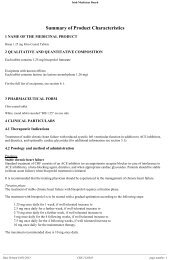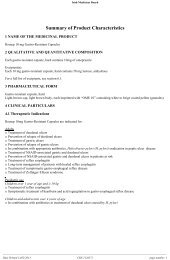Download Alopur 100mg SPC here - Rowex Ltd
Download Alopur 100mg SPC here - Rowex Ltd
Download Alopur 100mg SPC here - Rowex Ltd
Create successful ePaper yourself
Turn your PDF publications into a flip-book with our unique Google optimized e-Paper software.
Irish Medicines Board1 NAME OF THE MEDICINAL PRODUCT<strong>Alopur</strong> 100 mg tabletsSummary of Product Characteristics2 QUALITATIVE AND QUANTITATIVE COMPOSITIONEach tablet contains 100 mg allopurinol.For a full list of excipients, see section 6.1.3 PHARMACEUTICAL FORMTabletWhite, round, biconvex tablets with a single-sided score notch. The tablet can be divided into equal halves.4 CLINICAL PARTICULARS4.1 Therapeutic IndicationsAdults All forms of hyperuricaemia not controllable by diet, with serum uric acid values in the range of 535 µmol/l (9mg/100 ml) and above and in clinical complications of hyperuricaemic states, particularly manifest gout, uratenephropathy, for the dissolution and prevention of uric acid stones as well as for the prevention of the formation ofcalcium oxalate stones in concurrent hyperuricaemiaAdults, children and adolescents ≥ 15 kg bodyweight Secondary hyperuricaemia of differing originChildren and adolescents ≥ 15 kg bodyweight Uric acid nephropathy during treatment of leukaemia Hereditary enzyme deficiency disorders, Lesch-Nyhan syndrome (partial or total hypoxanthin-guaninphosphoribosyl transferase deficiency) and adenine phosophoribosyl transferase deficiency.4.2 Posology and method of administrationDosage in adultsAllopurinol should be introduced at a low dosage e.g. 100 mg/day to reduce the risk of adverse reactions and increasedonly if the serum urate response is unsatisfactory. Extra caution should be exercised if renal function is poor (see“Dosage in impaired renal function”).The following dosage schedules are suggested:100 mg to 200 mg daily in mild conditions,300 mg to 600 mg in moderately severe conditions,700 mg to 900 mg daily in severe conditions.Dosage higher than 300 mg should be given in divided doses not exceeding 300 mg at any time. If dosage on a mg/kgbodyweight basis is required, 2-10 mg/kg bodyweight/day should be used.Dosage in children and adolescents ≥ 15 kg bodyweightThe daily dose is 10 mg allopurinol per kilogram bodyweight (maximum 400 mg daily) given in 3 divided doses.______________________________________________________________________________________________________________________Date Printed 14/02/2013 CRN 2122997 page number: 1
Irish Medicines BoardDosage in elderly patientsAs t<strong>here</strong> are no specific data available on the use of allopurinol in elderly patients, this patient group should be treatedwith the lowest therapeutically justifiable dosage. Furthermore, the possibility of impaired renal function should beconsidered, especially in older patients.Dosage in impaired renal functionAs allopurinol and its metabolites are excreted via the kidney, overdose can occur in cases of impaired renal functionif the dosage is not adjusted appropriately.For this reason, an adjustment of the recommended dosage is indicated to minimise this risk. In cases of severeimpairment of kidney function, a maximum of 100 mg allopurinol should be administered daily, or single doses of100 mg should be administered at intervals of more than a day. The respective dose should be raised only if the effectsare inadequate. The level of oxypurinol in the serum should not exceed a value of 15.2 µg/ml.The following table provides guidance for the dosage in case of renal insufficiency:Creatinine Clearance Daily Dose> 20 ml/min standard dose10 to 20 ml/min 100 to 200 mg< 10 ml/min 100 mg or 100 mg every 2or 3 daysIn case of haemodialysis 300 mg to 400 mg allopurinol can be administered immediately after every treatment session(i.e. 2 or 3 times weekly).Dosage in impaired hepatic functionReduced doses should be used in patients with hepatic impairment. Periodic liver function tests are recommendedduring the early stages of therapy.Method and duration of treatmentThe tablets should be taken unchewed with plenty of liquid after a meal. If the daily dose of 300 mg allopurinol isexceeded or if symptoms of gastrointestinal intolerance occur, the dose should be divided and administered over thecourse of the day.The duration of treatment depends upon the underlying disorder. In order to prevent formation of calcium oxalate anduric acid stones and in cases of primary hyperuricaemia and gout, long-term therapy is necessary in most cases. Incases of secondary hyperuricaemia, transient treatment in accordance with the duration of raised uric acid values isrecommended.4.3 ContraindicationsHypersensitivity to the active substance allopurinol or to any of the excipientsChildren < 15 kg bodyweight4.4 Special warnings and precautions for useHypersensitivity syndrome, SJS and TENAllopurinol hypersensitivity reactions can manifest in many different ways, including maculopapular exanthema,hypersensitivity syndrome (also known as DRESS) and SJS/TEN. These reactions are clinical diagnoses, and theirclinical presentations remain the basis for decision making. If such reactions occur at any time during treatment,allopurinol should be withdrawn immediately. Rechallenge should not be undertaken in patients with hypersensitivitysyndrome and SJS/TEN. Corticosteroids may be beneficial in overcoming hypersensitivity skin reactions.HLA-B*5801 alleleThe HLA-B*5801 allele has been shown to be associated with the risk of developing allopurinol related______________________________________________________________________________________________________________________Date Printed 14/02/2013 CRN 2122997 page number: 2
Irish Medicines Boardhypersensitivity syndrome and SJS/TEN. The frequency of the HLA-B*5801 allele varies widely between ethnicpopulations: up to 20% in Han Chinese population, about 12% in the Korean population and 1-2% in individuals ofJapanese or European origin. The use of genotyping as a screening tool to make decisions about treatment withallopurinol has not been established. If the patient is a known carrier of HLA-B*5801, the use of allopurinol may beconsidered if the benefits are thought to exceed risks. Extra vigilance for signs of hypersensitivity syndrome orSJS/TEN is required and the patient should be informed of the need to stop treatment immediately at the firstappearance of symptoms.According to recent recommendations expressed in the literature, treatment with medicinal products is unnecessary ifuric acid levels are below 535 µmol/l (equivalent to 9 mg/100 ml), providing dietary recommendations are followedand t<strong>here</strong> is no kidney damage. Foods with high purine content (e.g. offal such as sweetbread, kidney, brain, liver, heartand tongue as well as meat extract) and alcohol (particularly beer, as this leads to uptake of guanosine, a ribonucleosidewhich profoundly raises the level of uric acid) should be avoided.If hypersensitivity reactions occur (e.g. exanthema) <strong>Alopur</strong> should be discontinued immediately.Particularly close monitoring by the physician is necessary in cases of impaired renal or hepatic function or pre-existinghaematopoiesis disorders. In patients with impaired renal or hepatic function the relevant dosage recommendationsmust be taken into account (see section 4.2). Especially in patients treated e.g. with ACE inhibitors or diuretics becauseof high blood pressure or cardiac insufficiency, allopurinol should be administered with caution, as patients in thisgroup can suffer from impaired renal function.In the treatment of renal gout and uric acid stones, the volume of urine produced should be at least 2 liters per day.In order to avoid raised concentrations of uric acid in the serum or the urine (as can occur in radiotherapy orchemotherapy of neoplasms as well as in Lesch-Nyhan-syndrome) in addition to administration of allopurinol, plentyof liquids should be taken to assure sufficient diuresis. Furthermore, alkalisation of the urine leading to improveddissolution of urate/uric acid can contribute to increased excretion of these substances.If urate nephropathy or any other pathological alteration has already caused impairment of renal function, the dosagemust be adjusted according to the renal function parameters (see section 4.2).Allopurinol treatment should not be started until an acute attack of gout has completely subsided, as further attacks maybe precipitated.In the early stages of treatment with Allopurinol, as with uricosuric agents, an acute attack of gouty arthritis may beprecipitated. T<strong>here</strong>fore it is advisable to give prophylaxis with a suitable anti-inflammatory agent or colchicine for atleast one month. The literature should be consulted for details of appropriate dosage and precautions and warnings.If acute attacks develop in patients receiving allopurinol, treatment should continue at the same dosage while the acuteattack is treated with a suitable anti-inflammatory agent.In the case of large uric acid stones in the renal pelvis, it cannot be excluded that parts of the stones dissolved duringtreatment with allopurinol could become trapped in the ureter.4.5 Interaction with other medicinal products and other forms of interaction6-mercaptopurine and azathioprineAzathioprine is metabolised to 6-mercaptopurine which is inactivated by the action of xanthine oxidase. When 6-mercaptopurine or azathioprine is given concurrently with allopurinol, only one-quarter of the usual dose of 6-mercaptopurine or azathioprine should be given because inhibition of xanthine oxidase will prolong their activity.Vidarabine (Adenine Arabinoside)Evidence suggests that the plasma half-life of vidarabine is increased in the presence of allopurinol. When the twoproducts are used concomitantly extra vigilance is necessary, to recognise enhanced toxic effects.Salicylates and uricosuric agents______________________________________________________________________________________________________________________Date Printed 14/02/2013 CRN 2122997 page number: 3
Irish Medicines BoardOxipurinol, the metabolite of allopurinol and itself therapeutically active, is excreted by the kidney in a similar way tourate. Hence, drugs with uricosuric activity such as probenecid or large doses of salicylate may accelerate the excretionof oxipurinol. This may decrease the therapeutic activity of allopurinol, but the significance needs to be assessed ineach case.ChlorpropamideIf allopurinol is given concomitantly with chlorpropamide when renal function is poor, t<strong>here</strong> may be an increased riskof prolonged hypoglycaemic activity because allopurinol and chlorpropamide may compete for excretion in the renaltubule.Coumarin anticoagulantsT<strong>here</strong> have been rare reports of increased effect of warfarin and other coumarin anticoagulants when co-administeredwith allopurinol, t<strong>here</strong>fore, all patients receiving anticoagulants must be carefully monitored.PhenytoinAllopurinol may inhibit hepatic oxidation of phenytoin but the clinical significance has not been demonstrated.TheophyllineInhibition of the metabolism of theophylline has been reported. The mechanism of the interaction may be explained byxanthine oxidase being involved in the biotransformation of theophylline in man. Theophylline levels should bemonitored in patients starting or increasing allopurinol therapy.Ampicillin/AmoxicillinAn increase in the frequency of skin rash has been reported among patients receiving ampicillin or amoxicillinconcurrently with allopurinol compared to patients who are not receiving both drugs. The cause of the reportedassociation has not been established. However, it is recommended that in patients receiving allopurinol an alternative toampicillin or amoxicillin is used w<strong>here</strong> available.Cyclophosphamide, doxorubicin, bleomycin, procarbazine, mechloroethamineEnhanced bone marrow suppression by cyclophosphamide and other cytotoxic agents has been reported among patientswith neoplastic disease (other than leukaemia), in the presence of allopurinol. However in a well-controlled study ofpatients treated with cyclophosphamide, doxorubicin, bleomycin, procarbazine and/or mechloroethamine (mustinehydrochloride) allopurinol did not appear to increase the toxic reaction of these cytotoxic agents.CyclosporinReports suggest that the plasma concentration of cyclosporin may be increased during concomitant treatment withallopurinol. The possibility of enhanced cyclosporin toxicity should be considered if the drugs are co-administered.DidanosineIn healthy volunteers and HIV patients receiving didanosine, plasma didanosine C maxand AUC values wereapproximately doubled with concomitant allopurinol treatment (300 mg daily) without affecting terminal half life.T<strong>here</strong>fore, dose reductions of didanosine may be required when used concomitantly with allopurinol.CaptoprilWith concomitant administration of allopurinol and captopril, the risk of skin reactions can be raised, especially in______________________________________________________________________________________________________________________Date Printed 14/02/2013 CRN 2122997 page number: 4
Irish Medicines Boardcases of chronic renal failure.4.6 Fertility, pregnancy and lactationPregnancy:T<strong>here</strong> are insufficient data available regarding use of allopurinol in pregnancy. Animal studies haveshown reproductive toxicity (see section 5.3). As allopurinol interferes with purine metabolism and the potential riskfor humans is not known, allopurinol should not be used during pregnancy, unless it is explicitly necessary.Lactation:Allopurinol and oxipurinol are secreted in small amounts into the mother’s milk. The dose to which the infant can thenbe exposed may approach the therapeutic level, however, effects on the infant have not been shown. Because of verylimited experience, allopurinol should not be used during the lactation period.4.7 Effects on ability to drive and use machinesWhile taking allopurinol undesirable effects as drowsiness, dizziness and ataxia might occur. The use of allopurinolmay reduce the ability to react thus impairing the ability to drive and the ability to operate machinery.4.8 Undesirable effectsThe evaluation of undesirable effects is based on the following frequency conventions:Very common (≥1/10)Common (≥1/100 to
Irish Medicines BoardWhen generalised hypersensitivity reactions have occurred, renal and/or hepatic disorder has usually been presentparticularly when the outcome has been fatal.Hepatobiliary disordersRare:• disorders of hepatic function, ranging from an asymptomatic rise in liver function parameters to hepatitis(including hepatic necrosis and granulomatous hepatitis) in extreme casesGastrointestional disordersUncommon:• nausea• vomiting• diarrhoeaVery rare:• haematemesis• steatorrhea• stomatitisBlood and lymphatic system disordersUncommon:• thrombocytopenia• agranulocytosis• aplastic anaemiaespecially in patients with renal dysfunction. Particularly careful monitoring of this patient group is t<strong>here</strong>forenecessary.Very rare:• altered blood counts such as leukopenia, leukocytosis, granulocytosis and eosinophilia• pure red cell aplasiaGeneral disorders and administration site conditions:Very rare:• general malaise• asthenia• oedemaRespiratory, thoracic and mediastinal disordersVery rare:• anginaNervous system disordersVery rare:• ataxia• peripheral neuritis• change in taste perception• coma• headache• neuropathy• paralysis• dizziness• somnolence• paraesthesiaCardiac disordersVery rare:______________________________________________________________________________________________________________________Date Printed 14/02/2013 CRN 2122997 page number: 6
Irish Medicines Board• bradycardiaMetabolism and nutrition disordersVery rare:• diabetes mellitus, hyperlipidaemiaPsychiatric disordersVery rare:• depressionReproductive system and breast disordersVery rare:• gynaecomastia• impotence• infertilityRenal and urinary disordersVery rare:• haematuria• uraemiaVascular disordersVery rare:• hypertensionEye disordersVery rare:• cataract• macular degeneration• visual impairmentMusculoskeletal and connective tissue disordersVery rare:• muscle pain4.9 OverdoseT<strong>here</strong> is no known specific antidote. After taking a single dose of 20 g, symptoms such as nausea, vomiting, diarrhoeaand dizziness occurred in one patient. In another patient a dose of 22.5 g resulted in no undesirable effects.If intoxication is suspected, especially in cases of co-medication with azathioprine or 6-mercaptopurine, the patient canbe helped to vomit or gastric lavage can be applied, in addition of administering activated coal and sodiumphosphate(only when the intake is not longer than an hour before).Extensive absorption of allopurinol can considerably inhibit the activity of xanthine-oxidase, which would not lead toadverse effects, unless it effects simultaneous applied medicines, especially azathioprine or 6-mercaptopurine. In such acase, the risk of an increased activity should be recognized.Maximal diuresis stimulates the excretion of allopurinol and its metabolites. When necessary, haemodialysis can beapplied.5 PHARMACOLOGICAL PROPERTIES5.1 Pharmacodynamic propertiesPharmacotherapeutic group: Antigout preparations; preparations inhibiting uric acid production,ATC code: M04 AA01Allopurinol, and its main metabolite oxypurinol, reduce the production of uric acid through inhibition of the enzyme______________________________________________________________________________________________________________________Date Printed 14/02/2013 CRN 2122997 page number: 7
Irish Medicines Boardxanthine oxidase, which plays an important role in the oxidation of hypoxanthine to uric acid. As a result, uric acidand urate levels in the body fluids and in urine are lowered.In addition to inhibition of the metabolism of purine, the de novo biosynthesis of purine is suppressed in somepatients through inhibition of hypoxanthine guanine phosphoribosyl transferase.5.2 Pharmacokinetic propertiesAllopurinol is active when given orally and is rapidly absorbed from the upper gastrointestinal tract. Studies havedetected allopurinol in the blood 30-60 minutes after dosing. Estimates of bioavailability vary from 67 % to 90 %. Peakplasma levels of allopurinol generally occur approximately 1.5 hours after oral administration of allopurinol, but fallrapidly and are barely detectable after 6 hours. Peak levels of oxipurinol generally occur after 3-5 hours after oraladministration of allopurinol and are much more sustained. Allopurinol is negligibly bound by plasma proteins andt<strong>here</strong>fore variations in protein binding are not thought to significantly alter clearance. The apparent volume ofdistribution of allopurinol is approximately 1.3 litre/kg which suggests relatively extensive uptake by tissues.Approximately 20 % of the ingested allopurinol is excreted in the faeces. Elimination of allopurinol is mainly bymetabolic conversion to oxipurinol by xanthine oxidase and aldehyde oxidase, with less than 10 % of the unchangeddrug excreted in the urine.Allopurinol has a plasma half-life of about 1 to 2 hours.Oxipurinol is a less potent inhibitor of xanthine oxidase than allopurinol, but the plasma half- life of oxipurinol is farmore prolonged. Estimates range from 13 to 30 hours in man. T<strong>here</strong>fore effective inhibition of xanthine oxidase ismaintained over a 24 hour period with a single daily dose of allopurinol. Patients with normal renal function willgradually accumulate oxipurinol until a steady-state plasma oxipurinol concentration is reached. Such patients, taking300 mg of allopurinol per day will generally have plasma oxipurinol concentrations of 5-10 mg/litre.Oxipurinol is eliminated unchanged in the urine but has a long elimination half-life because it undergoes tubularreabsorption. Reported values for the elimination half-life range from 13.6 hours to 29 hours. The large discrepancies inthese values may be accounted for by variations in study design and/or creatinine clearance in the patients.Pharmacokinetics in patients with renal impairmentAllopurinol and oxipurinol clearance is greatly reduced in patients with poor renal function resulting in higher plasmalevels in chronic therapy. Patients with renal impairment, w<strong>here</strong> creatinine clearance values were between 10 and 20ml/min, showed plasma oxipurinol concentrations of approximately 30 mg/litre after prolonged treatment with 300 mgallopurinol per day. This is approximately the concentration which would be achieved by doses of 600 mg/day in thosewith normal renal function. A reduction in the allopurinol dose is t<strong>here</strong>fore required in patients with renal impairment.Pharmacokinetics in elderly patientsThe kinetics of the drug are not likely to be altered other than due to deterioration in renal function (seePharmacokinetics in patients with renal impairment).5.3 Preclinical safety dataAfter prolonged use of allopurinol in animal studies, precipitation of xanthine precipitates occurred with high doses,and this led to changes in the efferent urinary organs.The in-vitro and in-vivo studies carried out to date revealed no evidence of a mutagenic or carcinogenic potential.In animal studies, teratogenic effects occurred from day 10 of gestation onwards in mice at high doses. Noteratogenic effects were shown in rats and rabbits.6 PHARMACEUTICAL PARTICULARS6.1 List of excipientsCellulose powderedPovidone K25Macrogol 4000______________________________________________________________________________________________________________________Date Printed 14/02/2013 CRN 2122997 page number: 8
Irish Medicines BoardCrospovidoneTalcMagnesium stearateMicrocrystalline cellulose6.2 IncompatibilitiesNot applicable.6.3 Shelf life5 yearsShelf life after first opening of the HDPE container: 6 months6.4 Special precautions for storageThis medicinal product does not require any special storage conditions.6.5 Nature and contents of containerPVC/aluminium and PP/aluminium blisters with 1, 7, 10, 25, 28, 30, 50, 90, 100 tabletsHDPE tablet containers with PE lid closures with 50, 100, 250, 500, 1000 tabletsNot all pack sizes may be marketed.6.6 Special precautions for disposal and other handlingNo special requirements.7 MARKETING AUTHORISATION HOLDER<strong>Rowex</strong> <strong>Ltd</strong>BantryCo. CorkIreland8 MARKETING AUTHORISATION NUMBERPA 711/154/1______________________________________________________________________________________________________________________Date Printed 14/02/2013 CRN 2122997 page number: 9
Irish Medicines Board9 DATE OF FIRST AUTHORISATION/RENEWAL OF THE AUTHORISATIONDate of first authorisation: 3rd April 200910 DATE OF REVISION OF THE TEXTFebruary 2013______________________________________________________________________________________________________________________Date Printed 14/02/2013 CRN 2122997 page number: 10



